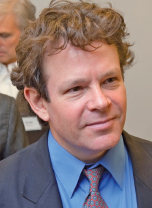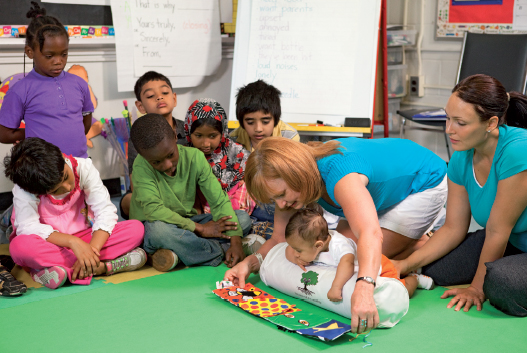David Bornstein, Fighting Bullying with Babies
| David Bornstein | Fighting Bullying with Babies |

DAVID BORNSTEIN has written popular books about solving social problems, including How to Change the World: Social Entrepreneurs and the Power of New Ideas (2007) and Social Entrepreneurship: What Everyone Needs to Know (2010). The recipient of several awards (for example, from Duke University’s Fuqua School of Business), Bornstein co-wrote the PBS documentary To Our Credit and founded Dowser.org. The following proposal, “Fighting Bullying with Babies,” originally appeared in Bornstein’s New York Times blog Fixes in November 2010. We have converted Bornstein’s links to in-text citations and have provided a list of the links at the end of the selection. We have also included photographs from the Roots of Empathy site that appeared in Borstein’s blog post.
As you read, think about Bornstein’s goal as described on the Dowser Web site to “present the world through a ‘solution frame,’ rather than a ‘problem frame,’” and consider the following questions:
- What is the tone created by his opening journalistic hook: “Imagine there was a cure for meanness. Well, maybe there is”?
- How does the reference in the next sentence to the Tyler Clementi suicide affect the tone created by the hook? Point to any other passages where the tone seems to change or seems surprising.
- Given his purpose and original New York Times blog audience, what do you imagine Bornstein is trying to achieve with tone in this kind of proposal?
1I magine there was a cure for meanness. Well, maybe there is. Lately, the issue of bullying has been in the news, sparked by the suicide of Tyler Clementi (“Tyler”), a gay college student who was a victim of cyber-bullying, and by a widely circulated New York Times article that focused on “mean girl” bullying in kindergarten (Paul). The federal government has identified bullying as a national problem. In August, it organized the first-ever “Bullying Prevention Summit,” and it is now rolling out an anti-bullying campaign aimed at 5- to 8-year old children (White House). This past month the Department of Education released a guidance letter (“Guidance”) urging schools, colleges and universities to take bullying seriously, or face potential legal consequences.
2The typical institutional response to bullying is to get tough. In the Tyler Clementi case, prosecutors are considering bringing hate-crime charges (Dolnick).1 But programs like the one I want to discuss today show the potential of augmenting our innate impulses to care for one another instead of just falling back on punishment as a deterrent. And what’s the secret formula? A baby.
1Tyler Clementi’s roommate, Dharun Ravi, was found guilty in March 2010 of fifteen counts, including invasion of privacy, tampering with evidence, and bias intimidation. [Editor’s note]
3We know that humans are hardwired to be aggressive and selfish. But a growing body of research is demonstrating that there is also a biological basis for human compassion (Angier). Brain scans reveal that when we contemplate violence done to others we activate the same regions in our brains that fire up when mothers gaze at their children, suggesting that caring for strangers may be instinctual. When we help others, areas of the brain associated with pleasure also light up. Research by Felix Warneken and Michael Tomasello indicates that toddlers as young as 18 months behave altruistically. (If you want to feel good, watch one of their 15-second video clips [Warneken]. . . .)
4More important, we are beginning to understand how to nurture this biological potential. It seems that it’s not only possible to make people kinder, it’s possible to do it systematically at scale—at least with school children. That’s what one organization based in Toronto called Roots of Empathy has done. Roots of Empathy was founded in 1996 by Mary Gordon, an educator who had built Canada’s largest network of school-based parenting and family-literacy centers after having worked with neglectful and abusive parents (Toronto District School Board). Gordon had found many of them to be lacking in empathy for their children. They hadn’t developed the skill because they hadn’t experienced or witnessed it sufficiently themselves. She envisioned Roots as a seriously proactive parent education program—one that would begin when the mothers- and fathers-to-be were in kindergarten. Since then, Roots has worked with more than 12,600 classes across Canada, and in recent years, the program has expanded to the Isle of Man, the United Kingdom, New Zealand, and the United States, where it currently operates in Seattle. Researchers have found that the program increases kindness and acceptance of others and decreases negative aggression.
5Here’s how it works: Roots arranges monthly class visits by a mother and her baby (who must be between two and four months old at the beginning of the school year). Each month, for nine months, a trained instructor guides a classroom using a standard curriculum that involves three 40-minute visits—a pre-visit, a baby visit, and a post-visit. The program runs from kindergarten to seventh grade. During the baby visits, the children sit around the baby and mother (sometimes it’s a father) on a green blanket (which represents new life and nature) and they try to understand the baby’s feelings. The instructor helps by labeling them. “It’s a launch pad for them to understand their own feelings and the feelings of others,” explains Gordon. “It carries over to the rest of class” (Gordon).
Tough kids smile, disruptive kids focus, shy kids open up.
6I have visited several public schools in low-income neighborhoods in Toronto to observe Roots of Empathy’s work. What I find most fascinating is how the baby actually changes the children’s behavior. Teachers have confirmed my impressions: tough kids smile, disruptive kids focus, shy kids open up. In a seventh grade class, I found 12-year-olds unabashedly singing nursery rhymes. The baby seems to act like a heart-softening magnet. No one fully understands why. Kimberly Schonert-Reichl, an applied developmental psychologist who is a professor at the University of British Columbia, has evaluated Roots of Empathy in four studies. “Do kids become more empathic and understanding? Do they become less aggressive and kinder to each other? The answer is yes and yes,” she explained. “The question is why?” (Schonert-Reichl).


7C. Sue Carter, a neurobiologist based at the University of Illinois at Chicago, who has conducted pioneering research into the effects of oxytocin, a hormone that has been linked with caring and trusting behavior, suspects that biology is playing a role in the program’s impact (Angier). “This may be an oxytocin story,” Carter told me. “I believe that being around the baby is somehow putting the children in a biologically different place. We don’t know what that place is because we haven’t measured it. However, if it works here as it does in other animals, we would guess that exposure to an infant would create a physiological state in which the children would be more social.”
8To parent well, you must try to imagine what your baby is experiencing. So the kids do a lot of “perspective taking.” When the baby is too small to raise its own head, for example, the instructor asks the children to lay their heads on the blanket and look around from there. Perspective taking is the cognitive dimension of empathy—and like any skill it takes practice to master. Children learn strategies for comforting a crying baby. They learn that one must never shake a baby. They discover that everyone comes into the world with a different temperament, including themselves and their classmates. They see how hard it can be to be a parent, which helps them empathize with their own mothers and fathers. And they marvel at how capacity develops. Each month, the baby does something that it couldn’t do during its last visit: roll over, crawl, sit up, maybe even begin walking. Witnessing the baby’s triumphs—even something as small as picking up a rattle for the first time—the children will often cheer.
9Ervin Staub, professor emeritus of psychology at the University of Massachusetts, has studied altruism in children and found that the best way to create a caring climate is to engage children collectively in an activity that benefits another human being (“Biographical Note”). In Roots, children are enlisted in each class to do something to care for the baby, whether it is to sing a song, speak in a gentle voice, or make a “wishing tree.” The results can be dramatic. In a study of first- to third-grade classrooms, Schonert-Reichl focused on the subset of kids who exhibited “proactive aggression”—the deliberate and cold-blooded aggression of bullies who prey on vulnerable kids (Schonert-Reichl et al.). Of those who participated in the Roots program, 88 percent decreased this form of behavior over the school year, while in the control group, only 9 percent did, and many actually increased it. Schonert-Reichl has reproduced these findings with fourth to seventh grade children in a randomized controlled trial. She also found that Roots produced significant drops in “relational aggression”—things like gossiping, excluding others, and backstabbing. Research also found a sharp increase in children’s parenting knowledge. “Empathy can’t be taught, but it can be caught,” Gordon often says—and not just by children. “Programmatically my biggest surprise was that not only did empathy increase in children, but it increased in their teachers,” she added. “And that, to me, was glorious, because teachers hold such sway over children.”
10When the program was implemented on a large scale across the province of Manitoba—it’s now in 300 classrooms there—it achieved an “effect size” that Rob Santos, the scientific director of Healthy Child Manitoba, said translates to reducing the proportion of students who get into fights from 15 percent to 8 percent, close to a 50 percent reduction (Healthy Child Manitoba). “For a program that costs only hundreds of dollars per child, the cost-benefit of preventing later problems that cost thousands of dollars per child, is obvious,” said Santos. Follow up studies have found that outcomes are maintained or enhanced three years after the program ends. “When you’ve got emotion and cognition happening at the same time, that’s deep learning,” explains Gordon. “That’s learning that will last.”
Links
Angier, Natalie. “The Biology Behind the Milk of Human Kindness.” New York Times. New York Times, 23 Nov. 2009. Web. 27 Mar. 2012.
Carter, Sue C. Personal interview. N.d.
Dolnick, Sam. “2 Linked to Suicide Case Withdraw from Rutgers.” New York Times. New York Times, 29 Oct. 2010. Web. 27 Mar. 2012.
Gordon, Mary. Personal interview. N.d.
Healthy Child Manitoba. “Putting Children and Families First.” Province of Manitoba, n.d. Web. 27 Mar. 2012.
Paul, Pamela. “The Playground Gets Even Tougher.” New York Times. New York Times, 8 Oct. 2010. Web. 27 Mar. 2012.
“Roots of Empathy: From Research to Recognition.” Roots of Empathy. Roots of Empathy, 2012. 27 Mar. 2012.
Schonert-Reichl, Kimberly. Personal interview. N.d.
Schonert-Reichl, Kimberly, et al. “Contextual Considerations in the Evaluation of a School-Based Social Emotional Competence Program.” American Educational Research Association, April 2009. Print.
Staub, Ervin. “Biographical Note.” Ervinstaub.com. Ervinstaub.com, n.d. Web. 27 Mar. 2012.
Toronto District School Board. “Parenting and Family Literacy Centres.” Toronto District School Board, n.d. Web. 27 Mar. 2012.
“Tyler Clementi.” Times Topics. New York Times. New York Times, 16 Mar. 2012. Web. 27 Mar. 2012.
United States. Dept. of Education. “Guidance Targeting Harassment Outlines Local and Federal Responsibility.” Ed.gov. Dept. of Education, 26 Oct. 2010. Web. 27 Mar. 2012.
____. Dept. of Health and Human Services. “Stop Bullying Now.” TFK Extra!. Health Resources and Services Administration, Dept. of Health and Human Services, n.d. Web. 27 Mar. 2012.
____. White House Conference on Bullying Prevention. White House. White House, 14 Oct. 2010. Web. 27 Mar. 2012.
Warneken, Felix. “Videoclips.” Dept. of Developmental and Comparative Psychology, Max Planck Institute for Evolutionary Anthropology. Max Planck Institute, n.d. Web. 27 Mar. 2012.
Warneken, Felix, and Michael Tomasello. “Altruistic Helping in Human Infants and Young Chimpanzees.” Science 311.5765 (2006): 1301–3. Academic Search Complete. Web. 27 Mar. 2012.